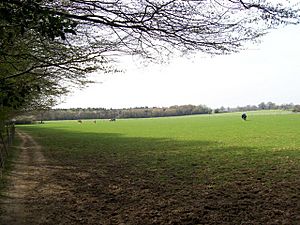The Treatise (Walter of Bibbesworth) facts for kids

The Treatise (original title Le Tretiz) is a special poem from the 1200s. It was written in a language called Anglo-Norman. This was a type of French spoken in England after the Normans came over. The poem was written by a man named Walter of Bibbesworth. He wrote it for a woman named Dionisie de Munchensi. His goal was to help her teach her children French. French was the language of the rich and powerful families, known as the Norman aristocracy, at that time. This book was very popular in medieval England. It is one of the first books ever made for children.
Contents
Who Wrote It and Why?
It's not clear how Walter and Dionisie knew each other. But their families lived near Hertford Fair. This fair happened every year starting in 1226. They might have met there.
Some copies of the book start with a note. It says the book was written for "Madame Dyonise de Mountechensi." Other copies have a letter at the beginning. This letter calls her "Chere suer," which means "Dear sister." This phrase showed they were friends and equals. The letter also says: "You asked me to write a phrase book for your children. It will help them learn French."
Dionisie's Family
Dionisie's last name was "de Anesty" before she got married. She married Warin de Munchensi in 1234. After her marriage, she had two stepchildren. Their names were John and Joan de Munchensi. They were the grandchildren of a famous knight, William Marshal. Soon after, Dionisie had her own child, William.
The book was probably written around the time Dionisie got married. Or it was written soon after. John, William, and Joan likely learned their French from this book. Dionisie herself was not very good at French. She needed help to make sure her children spoke French well. Knowing French was very important for their future. William became a politician. Joan got a very rich inheritance in 1247. King Henry III chose her to marry his half-brother, William of Valence, in the same year.
What's Inside the Book?
Walter probably wanted Dionisie to read the book aloud. He expected the children to look at the text as she read. The poem has rhyming lines. The lines are usually 7 or 8 syllables long.
The book covers many different topics. It starts with birth and childhood. Then it lists plants and animals. It even lists the sounds animals make! It continues with daily tasks around the house and farm. This includes fishing, baking, and brewing drinks. It also talks about building houses, ploughing fields, and using carts. The book ends with a description of a "great feast." The book really focuses on how to manage a home and a large estate.
The lists of animal groups and animal sounds are very special. They are the first known lists of these words in any European language.
Learning French with English Help
Many important French words in the book have English translations. These translations are written between the lines or in the margins. This shows that the book was for children who spoke English first. French was their second language. The book's goal was to help them "be better taught in speech." This way, they would not be made fun of by others.
The Treatise was a big moment in the history of language in medieval England. It shows that by the time it was written, English was already the main language. Even the children of the rich Norman families spoke English first. They learned English before they learned French. This book is one of the very first books made "for children to hear and read." It stayed popular for 200 years. Many copies of it still exist. It was even used again in a later collection called Femina Nova. That collection was for older students. By then, fewer English children learned French when they were very young.
Images for kids


